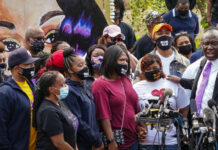The court’s action left in place a court order requiring prison officials to move more than 800 older or medically vulnerable prisoners from a facility that has seen nine deaths from Covid-19.

WASHINGTON — The Supreme Court on Tuesday refused a request from the Trump administration to block a trial judge’s ruling that had ordered federal prison officials to take steps to protect more than 800 older or medically vulnerable inmates at Elkton Federal Correctional Institution in Ohio, where nine prisoners have died from the coronavirus.
The Supreme Court’s brief, unsigned order turned in part on a procedural issue, and the majority said it might revisit the issue “if circumstances warrant.” Justices Clarence Thomas, Samuel A. Alito Jr. and Neil M. Gorsuch said they would have granted the administration’s request for a stay.
Four prisoners filed a class-action lawsuit last month saying that conditions at the prison violated the Eighth Amendment’s prohibition of cruel and unusual punishment. In a Supreme Court brief on their behalf, lawyers with the American Civil Liberties Union wrote that the prisoners were unable to take the most rudimentary efforts to protect themselves.
“They are housed, cheek by jowl, in dormitory-style rooms of approximately 150 persons each,” the brief said. “Though well aware that social distancing is an indispensable means of protecting themselves, they are powerless to use it. The result has been a severe Covid-19 outbreak lasting months, causing the deaths — so far — of at least nine people and infecting hundreds more among prisoners and staff.”
Elkton is a low-security prison that houses about 2,400 inmates. More than 800 of them are over 65 years old or have health conditions making them especially vulnerable to the coronavirus.
In a series of rulings, Judge James S. Gwin of the Federal District Court in Cleveland ordered officials to remove the most vulnerable inmates from the prison through compassionate release, home confinement, parole or transfer to another facility.
“It bears repeating,” Judge Gwin wrote on April 22, that the plaintiffs “are not asking the court to dump inmates out into the streets. No one’s interest would be served in doing so. The court is confident that the transfer of prisoners from Elkton to other means of confinement could accomplish the goal of protecting Elkton’s vulnerable population while also protecting public safety.”
Although testing has been limited, Judge Gwin wrote on May 19, “so far the data demonstrates that almost one in four inmates at Elkton has been infected — an unacceptable number.”
After an appeals court turned down the officials’ request for a stay, Solicitor General Noel J. Francisco asked the Supreme Court to intercede, saying that Judge Gwin’s first order threatened public safety and amounted to unwarranted judicial interference with prison administration.
The A.C.L.U. responded that the administration had not sought a stay of Judge Gwin’s May 19 order, a point the Supreme Court found significant. “Particularly in light of that procedural posture,” the majority wrote, “the court declines to stay the district court’s April 22 preliminary injunction without prejudice to the government seeking a new stay if circumstances warrant.”
The A.C.L.U.’s brief said officials had not responded adequately to the crisis in the prison.
“The government has demonstrated for months that it will not take the necessary action at Elkton to save the lives of its charges,” the group’s brief said. “As of today, despite the lack of mass testing, there are 128 confirmed and currently active cases of Covid-19 among Elkton prisoners, plus eight more among staff. The true number is likely far higher. Yet not a single prisoner, no matter how vulnerable, has been transferred out.”
“People are continuing to die,” the brief said. “When this action was filed in mid-April, three Elkton prisoners had died. Three more died within the week. The toll reached nine on May 8. The government’s complaint of administrative inconvenience cannot outweigh the risk of severe illness and death to petitioners in prison.”
In response, Mr. Francisco wrote that prison officials had been working hard to lower the risk of infection but that the prisoners were asking for too much.
“Respondent’s position, if correct,” Mr. Francisco wrote, “would impose a constitutional six-feet-at-all-times rule that would require the release of inmates from low-security facilities even where prison officials have taken extensive efforts to mitigate the risk of spread, and even while most law-abiding citizens in today’s society cannot guarantee themselves such protections at all times.”







